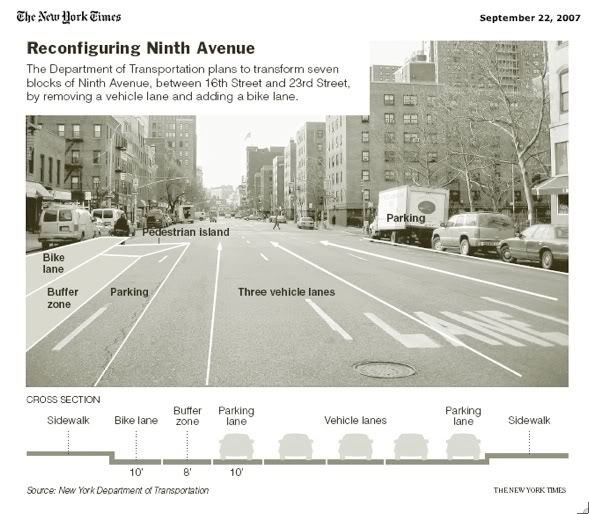Glad to see this sort of progress in New York.
Toronto, take note!
----
From this weekend's NY Times:
A Busy City Street Makes Room for Bikes
By WILLIAM NEUMAN
Cyclists and pedestrians never quite imagined it this way, but maybe there is a use for all those cars after all.
The city is planning to remake seven blocks of Ninth Avenue in Chelsea into what officials are billing enthusiastically, perhaps a bit hyperbolically, as the street of the future.
The most unusual aspect of the design, which will run from 16th Street to 23rd Street, is that it uses a lane of parked cars to protect cyclists from other traffic.
It does this by placing the bike lane directly next to the sidewalk on the western edge of Ninth Avenue, which is the left side of the street for those facing north, in the direction of traffic. The plan also takes a lane from cars, creating more room for pedestrians and for the bicycle lane.
“I think it’s a sneak peek at the future streets of New York,†said Janette Sadik-Khan, the city’s transportation commissioner. “It represents the kinds of innovative ideas that we can explore to make the streets more livable.â€
Next to the bike lane, which will be 10 feet wide, will be an eight-foot section of pavement that will act as a buffer, with plastic posts and large planters to keep cars from entering. The parking lane will be to the right of the buffer zone, and beyond that will be three lanes for traffic.
The result will be a barrier of parked cars between cyclists and moving vehicles.
“For cyclists, you’ve got a physically separate lane that prevents motorists from coming in,†Ms. Sadik-Khan said.
It is a design that has been used in cities in Europe but never in New York City.
Another feature will make life easier for people on foot. At each intersection, a raised island will extend into the avenue. Called a “pedestrian refuge,†it has the effect of shortening the distance traveled to cross the street to 45 feet, from 70 feet.
Ms. Sadik-Khan said that work would begin shortly and that the remade street would be completed by next month.
As part of the plan, single-space parking meters will be replaced by Muni-Meters, which control many spaces, and the cost of parking will increase to $2 an hour from $1.50.
Ms. Sadik-Khan said the makeover of the avenue was possible because traffic volume in the area was low enough that cars could move as smoothly in three lanes as in four.
It is not difficult to see how that rationale could dovetail with Mayor Michael R. Bloomberg’s proposal for congestion pricing, which would charge drivers a fee to use the streets of Manhattan below 86th Street. The fee is supposed to reduce the volume of traffic, which could theoretically free up street space for other uses.
Noah S. Budnick, the deputy director of Transportation Alternatives, an advocacy group that works to improve conditions for cyclists and pedestrians, said he thought a protected bike lane would encourage more New Yorkers to get on bikes.
“If you talk to the average New Yorker, they’d ride a bike, but most people say the traffic is too scary,†Mr. Budnick said. He pointed to the example of a popular bike path in Hudson River Park.
“If you provide protected space for riding bikes, New Yorkers are going to use it in droves,†he said.
Mr. Budnick was asked if the idea of parked cars protecting cyclists changed his view of the oversized S.U.V.’s that are often the bugaboo of bikers and environmentalists. After all, the bigger the car, the better the barrier.
“As lon as they’re not moving,†he said.





